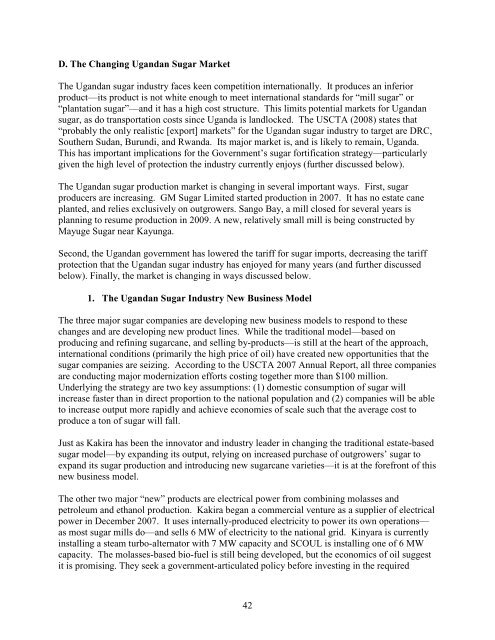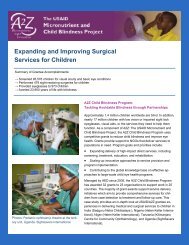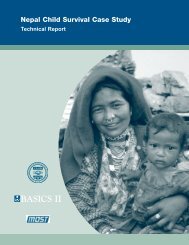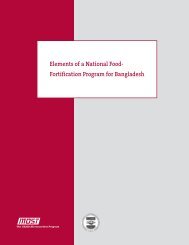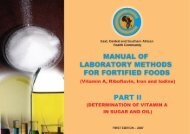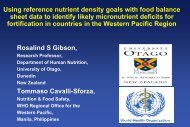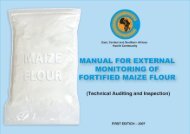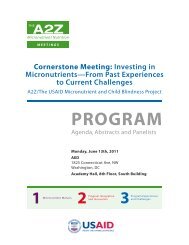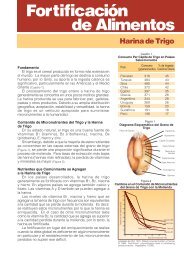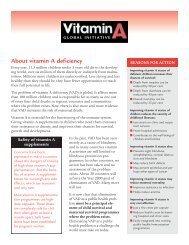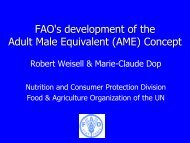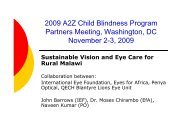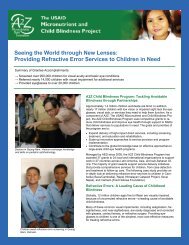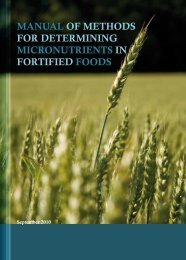Fortification of Vegetable oil and Sugar with Vitamin A in Uganda
Fortification of Vegetable oil and Sugar with Vitamin A in Uganda
Fortification of Vegetable oil and Sugar with Vitamin A in Uganda
You also want an ePaper? Increase the reach of your titles
YUMPU automatically turns print PDFs into web optimized ePapers that Google loves.
D. The Chang<strong>in</strong>g Ug<strong>and</strong>an <strong>Sugar</strong> Market<br />
The Ug<strong>and</strong>an sugar <strong>in</strong>dustry faces keen competition <strong>in</strong>ternationally. It produces an <strong>in</strong>ferior<br />
product—its product is not white enough to meet <strong>in</strong>ternational st<strong>and</strong>ards for “mill sugar” or<br />
“plantation sugar”—<strong>and</strong> it has a high cost structure. This limits potential markets for Ug<strong>and</strong>an<br />
sugar, as do transportation costs s<strong>in</strong>ce Ug<strong>and</strong>a is l<strong>and</strong>locked. The USCTA (2008) states that<br />
“probably the only realistic [export] markets” for the Ug<strong>and</strong>an sugar <strong>in</strong>dustry to target are DRC,<br />
Southern Sudan, Burundi, <strong>and</strong> Rw<strong>and</strong>a. Its major market is, <strong>and</strong> is likely to rema<strong>in</strong>, Ug<strong>and</strong>a.<br />
This has important implications for the Government’s sugar fortification strategy—particularly<br />
given the high level <strong>of</strong> protection the <strong>in</strong>dustry currently enjoys (further discussed below).<br />
The Ug<strong>and</strong>an sugar production market is chang<strong>in</strong>g <strong>in</strong> several important ways. First, sugar<br />
producers are <strong>in</strong>creas<strong>in</strong>g. GM <strong>Sugar</strong> Limited started production <strong>in</strong> 2007. It has no estate cane<br />
planted, <strong>and</strong> relies exclusively on outgrowers. Sango Bay, a mill closed for several years is<br />
plann<strong>in</strong>g to resume production <strong>in</strong> 2009. A new, relatively small mill is be<strong>in</strong>g constructed by<br />
Mayuge <strong>Sugar</strong> near Kayunga.<br />
Second, the Ug<strong>and</strong>an government has lowered the tariff for sugar imports, decreas<strong>in</strong>g the tariff<br />
protection that the Ug<strong>and</strong>an sugar <strong>in</strong>dustry has enjoyed for many years (<strong>and</strong> further discussed<br />
below). F<strong>in</strong>ally, the market is chang<strong>in</strong>g <strong>in</strong> ways discussed below.<br />
1. The Ug<strong>and</strong>an <strong>Sugar</strong> Industry New Bus<strong>in</strong>ess Model<br />
The three major sugar companies are develop<strong>in</strong>g new bus<strong>in</strong>ess models to respond to these<br />
changes <strong>and</strong> are develop<strong>in</strong>g new product l<strong>in</strong>es. While the traditional model—based on<br />
produc<strong>in</strong>g <strong>and</strong> ref<strong>in</strong><strong>in</strong>g sugarcane, <strong>and</strong> sell<strong>in</strong>g by-products—is still at the heart <strong>of</strong> the approach,<br />
<strong>in</strong>ternational conditions (primarily the high price <strong>of</strong> <strong>oil</strong>) have created new opportunities that the<br />
sugar companies are seiz<strong>in</strong>g. Accord<strong>in</strong>g to the USCTA 2007 Annual Report, all three companies<br />
are conduct<strong>in</strong>g major modernization efforts cost<strong>in</strong>g together more than $100 million.<br />
Underly<strong>in</strong>g the strategy are two key assumptions: (1) domestic consumption <strong>of</strong> sugar will<br />
<strong>in</strong>crease faster than <strong>in</strong> direct proportion to the national population <strong>and</strong> (2) companies will be able<br />
to <strong>in</strong>crease output more rapidly <strong>and</strong> achieve economies <strong>of</strong> scale such that the average cost to<br />
produce a ton <strong>of</strong> sugar will fall.<br />
Just as Kakira has been the <strong>in</strong>novator <strong>and</strong> <strong>in</strong>dustry leader <strong>in</strong> chang<strong>in</strong>g the traditional estate-based<br />
sugar model—by exp<strong>and</strong><strong>in</strong>g its output, rely<strong>in</strong>g on <strong>in</strong>creased purchase <strong>of</strong> outgrowers’ sugar to<br />
exp<strong>and</strong> its sugar production <strong>and</strong> <strong>in</strong>troduc<strong>in</strong>g new sugarcane varieties—it is at the forefront <strong>of</strong> this<br />
new bus<strong>in</strong>ess model.<br />
The other two major “new” products are electrical power from comb<strong>in</strong><strong>in</strong>g molasses <strong>and</strong><br />
petroleum <strong>and</strong> ethanol production. Kakira began a commercial venture as a supplier <strong>of</strong> electrical<br />
power <strong>in</strong> December 2007. It uses <strong>in</strong>ternally-produced electricity to power its own operations—<br />
as most sugar mills do—<strong>and</strong> sells 6 MW <strong>of</strong> electricity to the national grid. K<strong>in</strong>yara is currently<br />
<strong>in</strong>stall<strong>in</strong>g a steam turbo-alternator <strong>with</strong> 7 MW capacity <strong>and</strong> SCOUL is <strong>in</strong>stall<strong>in</strong>g one <strong>of</strong> 6 MW<br />
capacity. The molasses-based bio-fuel is still be<strong>in</strong>g developed, but the economics <strong>of</strong> <strong>oil</strong> suggest<br />
it is promis<strong>in</strong>g. They seek a government-articulated policy before <strong>in</strong>vest<strong>in</strong>g <strong>in</strong> the required<br />
42


